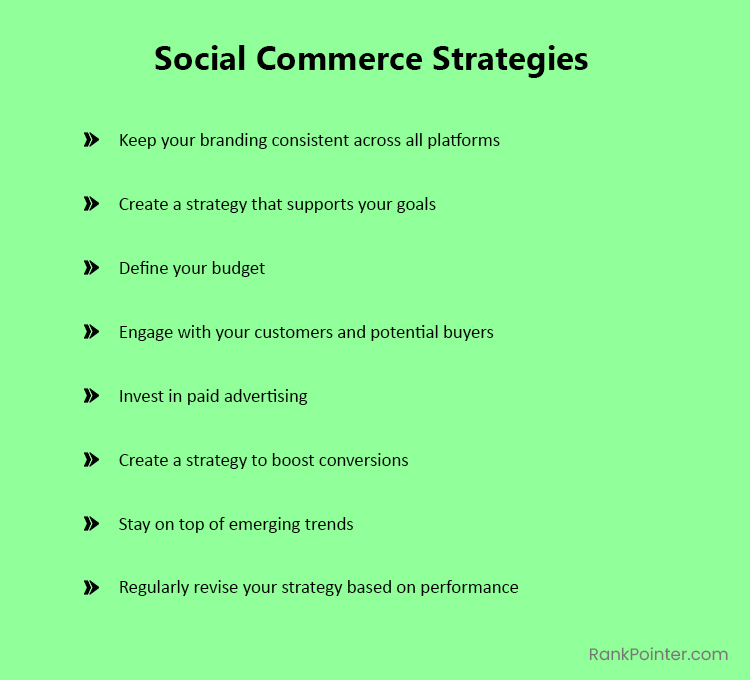Social commerce strategies have thrived, having a remarkable compound annual growth rate (CAGR) of nearly 30%. The reason why is also not a mystery. People use social media on average for two and a half hours every day all across the world. They may shop, engage with friends, and get news and entertainment all in one location.
In 2022, social commerce generated revenues of close to $1 trillion. With the anticipated $3 trillion global eCommerce market, social commerce might account for up to a third of all eCommerce revenues. So now is the time to get moving on building a social commerce strategy for your company. For businesses looking to tap into this growing trend, considering the expertise of a social media marketing company can be a valuable resource.
What are the fundamentals of developing an effective social commerce strategy?
An effective social commerce strategy requires thought and effort to develop. you guarantee you get the most out of your efforts, make sure you invest time in the following areas:
1. Keep your branding consistent across all platforms
When it comes to social commerce, consistency is crucial. Success depends on creating a recognizable brand presence and ensuring that messaging, tone, and content are constant across all social media platforms.
For your creative team to use as a reference when writing copy for products and advertisements, organizing photo and video shoots, and creating graphic layouts, create a brand identity guide. This will make customers more familiar with your brand and at ease wherever they are shopping. A social media marketing company will let your business have consistent branding across various social media channels.
2. Create a strategy that supports your goals
Establish a social media plan that will support your unique objectives before creating content or spending money on any creative assets. Consider the content types you want to produce, the places where you’ll publish them, and the social commerce strategies you’ll use.
In order to create a social commerce strategy that works, you must conduct extensive research on the social media channels that complement your brand and target market. To decide where you should concentrate your resources, take into account social media trends, user behaviors, and industry best practices. Make a social media content calendar in advance to aid in planning promotions and campaigns.
3. Define your budget
The key to successful social commerce is the careful goal- and budget-setting. Make sure your budget covers all the expenses associated with launching your outlets and advertising your products.
In addition to any weekly, monthly, quarterly, or annual reports, explicitly outline your goals so that they are measurable at the end of every campaign.
4. Engage with your customers and potential buyers
Advertising can increase brand awareness and sales, but nothing influences potential customers like human interaction. Gaining trust requires proactive, genuine interaction. As a result, leave comments on articles where your business is mentioned, reply to comments on your own content and advertisements, share client images and videos, and promptly respond to direct messages.
By leaving comments on articles that are pertinent to your field or products, you can also immediately connect with prospective clients and begin developing a relationship with them. To grab people’s attention, send sponsored direct messages to individuals who have already visited your website and follow users across several platforms.
5. Invest in paid advertising
While having a successful social commerce store may not require paid promotion, many businesses discover that it is vital to achieving their objectives.
You should usually start with some rather basic ads if you’re new to social advertising. For instance, you can reuse organic material that was successful in the past as an advertisement. Alternatively, if a specific print advertisement, direct mail piece, or other campaign has been successful for you, you can modify it for social media and see if it does the same.
6. Create a strategy to boost conversions
Sales might not proceed at the rate you’d like even with excellent products and enthusiastic customers. You must invest time in creating closing tactics if you want to turn browsers into clients. Making sure consumers have the knowledge they require, believe in your company and its offerings, and perceive a need to act quickly is your aim.
Learn more about Five tips to help turn a business’ social presence into sales
7. Stay on top of emerging trends
Social media networks frequently introduce new features while also removing others. It’s critical to keep up with current advancements so that you may modify your strategy in a way that will be advantageous to your company.
Fight your fear of change! Being a leading brand can be achieved by being an early user of any new social shopping capabilities.
8. Regularly revise your strategy based on performance
Social commerce is a field that is always being improved and optimized. Reviewing the effectiveness of your products and campaigns on a regular basis will help you make improvements that will enhance your outcomes and help you accomplish your goals.
When evaluating the success of a campaign, take into account variables like audience engagement levels, social media reach, conversion rates, cost per acquisition (CPA), and any other variables that are significant to your company.

Social Commerce Strategies and Best Practices – Summary
The major social commerce strategies include keeping consistent branding, having a plan to achieve the goals, engage with the customers, and many more. You should follow them properly to increase sales.
Frequently Asked Questions
What is social commerce?
Social commerce is a subset of eCommerce that involves selling products or services directly through social media platforms. It’s growing rapidly due to the widespread use of social media, which allows people to shop, interact with friends, and access news and entertainment in one place. In 2022, it generated nearly $1 trillion in revenues.
Why is branding consistency important in social commerce?
Branding consistency is crucial in social commerce because it helps create a recognizable brand presence, ensuring that your messaging, tone, and content are uniform across all social media platforms. This familiarity makes customers more comfortable while shopping.
How can I engage with customers and potential buyers effectively?
Engage with customers and potential buyers through proactive, genuine interaction. This includes leaving comments on articles, responding to comments on your content and advertisements, sharing client images and videos, and responding promptly to direct messages. You can also send sponsored direct messages to previous website visitors.
Useful Article: How to Develop an eCommerce Marketing Plan to Boost Sales?
Can social media marketing lead to increased sales in social commerce?
Yes, social media marketing can directly contribute to increased sales by creating a seamless shopping experience on social platforms and using effective advertising strategies that prompt users to make purchases.
Related Article: Benefits of Facebook Marketing for Small Businesses
Why should businesses invest in paid advertising for social commerce?
While not always necessary, paid advertising is crucial for many businesses to achieve their objectives in social commerce. It’s recommended to start with basic ads, repurposing successful organic content or adapting print advertisements for social media. Collaborating with a PPC agency can further optimize the effectiveness of your paid advertising efforts by leveraging their expertise in managing and fine-tuning ad campaigns.
How often should I revise my social commerce strategy based on performance?
Social commerce is an evolving field, and it’s important to regularly review the effectiveness of your products and campaigns. Factors to consider when evaluating success include audience engagement, social media reach, conversion rates, cost per acquisition (CPA), and other relevant variables. Make improvements to enhance outcomes and achieve your goals.


